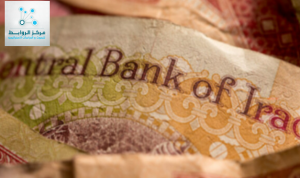BY: Shatha kalel
The Iraqi banking sector has witnessed significant growth in recent years, reflecting substantial efforts to modernize the financial system and strengthen economic stability. This growth serves as evidence of Iraq’s progress in improving financial infrastructure and building confidence in the banking system, contributing to a considerable increase in bank assets. The latest analysis of the development of Iraqi banks’ assets over five years shows a variation in growth rates between banks with correspondent accounts in the United States, banks focusing on local or regional transactions, and those engaged in foreign financial transactions.
In this context, this analysis addresses the factors driving this growth, the challenges that may impact it, and potential economic opportunities arising from this banking expansion, as illustrated in the chart below.
1. Strong Growth in Banks with Correspondent Accounts in American Banks
Banks with correspondent accounts in American banks have shown remarkable growth, with their assets increasing by 240.4% from 2019 to 2024. This category now represents 34.5% of total bank assets in 2024. This growth reflects the increasing integration of Iraqi banks into the global financial system, especially with U.S. financial institutions. This may be due to improved regulatory frameworks, increased confidence in Iraqi banking operations, or heightened demand for international transactions facilitated by correspondent banking relationships.
Potential Economic Impact: Enhanced international banking relationships can support trade and investment, making it easier for Iraqi companies to conduct cross-border transactions. This could boost foreign direct investment (FDI) and stimulate economic diversification by facilitating access to foreign capital and goods.
2. Moderate Growth in Banks Without Correspondent Accounts in American Banks
Banks without correspondent accounts in the United States have experienced stable growth of 78.7% over six years, with an annual growth rate of 7.1%. This steady growth reflects these banks’ reliance on local or regional clients rather than international partnerships. These banks may primarily serve sectors of the economy focused on the domestic or regional market.
Potential Economic Impact: Although these banks contribute significantly to the financial system, their limited international exposure may restrict their growth potential and access to foreign capital. Nonetheless, they continue to play a vital role in supporting local businesses and consumers, promoting financial inclusion within Iraq.
3. Decline in Growth Among Banks Engaged in Foreign Financial Transactions
Banks conducting foreign financial transactions saw substantial asset growth from 2019 to 2023 but experienced a decline in 2024 with an annual negative growth rate of -11.8%.
Implications: The sudden drop in growth among these banks may indicate regulatory challenges, geopolitical changes, or a decrease in foreign financial transactions. This could also reflect a cautious approach toward foreign dealings amidst international sanctions or currency restrictions.
Potential Economic Impact: A decline in foreign transaction activities could impact Iraq’s financial connectivity to the global market, affecting sectors reliant on imports or exports. If this trend continues, it may indicate tightened capital flows, potentially limiting access to international markets and hindering economic growth.
4. Overall Growth in the Iraqi Banking Sector
Total assets of Iraqi banks doubled from IQD 15.6 trillion in 2019 to IQD 31.8 trillion in 2024, representing a 104.6% growth over six years, with an annual growth rate of 9.6%. This overall growth reflects increased financial activity, potentially driven by economic reforms, government support, and modernization efforts in the banking sector. It aligns with broader economic goals to diversify Iraq’s economy and reduce its reliance on oil revenues.
Potential Economic Impact: A stronger banking sector can provide crucial support for economic development by increasing the availability of credit for businesses and consumers. This growth also reflects greater public confidence in the banking system, which is essential for long-term economic stability. Additionally, increased banking assets can support Iraq’s ambitions to attract foreign investment and strengthen its non-oil sectors.
Key Economic Considerations and Future Outlook
Need for Regulatory Support and Infrastructure: To sustain this growth, continuous improvement in regulatory frameworks, information security, and anti-money laundering measures is necessary. Strengthening regulations and transparency will help build trust among international partners and attract further foreign investment.
Enhancing Foreign Relations for Diversification: The significant growth in banks with U.S. banking relationships suggests that expanding international partnerships could benefit the sector. Strengthening relationships with banks in other regions, such as Europe or Asia, can reduce dependence on a single market and diversify economic risks.
Potential Risks from Geopolitical Tensions: Iraq’s banking sector remains vulnerable to regional unrest and international sanctions. A proactive approach to diversifying external partnerships and reducing exposure to high-risk regions can help mitigate these risks.
Focus on Financial Inclusion: Although growth has been substantial, ensuring banking services reach all segments of society, including underserved rural areas, is essential. Financial inclusion initiatives can support small businesses, which are crucial for job creation and economic diversification.
Addressing the Decline in Banks Engaged in Foreign Transactions: The negative growth trend among banks engaged in foreign financial transactions in 2024 should be investigated to understand underlying causes. Policy adjustments or strategic shifts may be needed to effectively reintegrate these banks into the network of international financial transactions.
Conclusion
The growth of Iraqi banks’ assets reflects a positive trend for its financial sector, supporting broader economic goals. To maintain this momentum, Iraq must strike a balance between strengthening international relationships and promoting local financial inclusion. By navigating geopolitical challenges and building a resilient financial system, the banking sector can play a pivotal role in Iraq’s journey toward a diversified and stable economy.
Economic Unit/North America Office
Al Rawabet Center for Research and Strategic Studies

